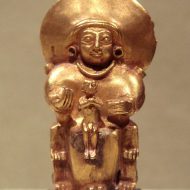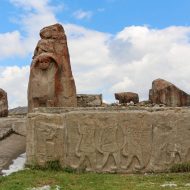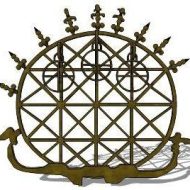Arinnitti : The Sun Goddess
Listen
At a glance
| Description | |
|---|---|
| Origin | Hittite Mythology |
| Classification | Gods |
| Family Members | Tahrun (Husband), Nerik, Telipinu, Zippalanda (Children) |
| Region | Turkey |
| Associated With | Sun, Judgement |
Arinnitti
Introduction
The sun goddess Arinnitti was the patron deity of the monarchy and the Hittite empire. Her consort, Tahrun, was also important but not as much, suggests that she may have originated during a matriarchal period. Her origin might have been linked to the fertility and earth goddess Anatolia. Arinnitti was a righteous woman with royal authority and functioned as a powerful protector whom the queen of the Hittites, Puduhepa, chose for her protection. Her seal showed that the queen embraced the goddess.
Physical Traits
In the city of Tarunpa, various solar disc statues were made and displayed. Each year, King Ulmi-Tsseup of Tarununta donated a Sun disc containing silver, gold, and copper to the goddess along with three sheep and a bull as gifts. Arinnitti was often depicted as a woman, and some of the statues depicted her with a halo and as a solar disc.
Queen Puduhepa said she would give her many deer in exchange for the protection of the sun goddess. It is believed that the vessels used for the worship of the sun goddess were made from the remains of a deer. The golden deer statues that were found in the Kzlrmak River during the Bronze Age were also associated with the Sun goddess’ cult.
Family
The sun goddess Arinnitti and the weather god Tahrun formed a pair that ruled the Hittite state’s pantheon. Their daughter, who was known as Mezulla had a daughter known as Zintuhi. Their other children were Nerik, Telipinu the corn god, and the weather god Zippalanda. The eagle served as their messenger.
Other Names
In Hittite mythology, Arinnitti was known as “queen of all lands” and was also referred to as Wurunsemu. The name Ištanu is the Hittite form of the Hattian name Eštan and refers to the Arinnitti as well.
Powers and Abilities
The Hittite kings and queens of Arinna worshipped Arinnitti, who was also known as the goddess of the sun. Arinnitti was attributed with righteous judgment and was seen as one of the most important deities in the Hittite pantheon. She was said to be the mother of all humans, and she was the source of all warmth.
Modern Day Influence
Despite being a very important deity for the Hittites, there is a lot of confusion surrounding Arinnitti as there has been numerous references and similarities with the various Middle Eastern mythologies. It becomes difficult to clear out the fact from the unclassified and undocumented information that is available out there. Research and information about Arinnitti is still very unstructured and fragmented with a lot of assumptions being made to fill in the gaps.
Related Images
Source
“Arinnitti | Hittite Queen, Anatolian Goddess, Storm Deity | Britannica.” Encyclopaedia Britannica, Link
“The Kaiamunu-Ébiha-Gi-Cult in the Delta-Region and Western Papua New Guinea.” Journal of Pacific History, 2004. Link
“Arinna Sun Goddess: Origins, Worship, and Symbolism in Hittite Culture.” Old World Gods, Link
Collins, Billy Jean. The Religion of the Hittites. Brill, 2003.
Frequently Asked Questions
Who is the goddess of the sun in Hittite?
In Hittite mythology, Arinitti is recognized as the goddess of the Sun. She is often depicted as a solar deity associated with warmth, light, and fertility. Arinitti was an important figure in the Hittite pantheon, and her worship included rituals that celebrated her life-giving powers, which were essential for agriculture and the well-being of the community. She is sometimes referred to as the wife of the storm god Tarhun and plays a significant role in various myths and religious practices of the Hittite civilization.
Who is the goddess Arinitti?
Arinitti is the Hittite goddess of the Sun, symbolizing warmth, light, and fertility. She is a vital deity in the Hittite pantheon, associated with agricultural prosperity and the life-giving power of sunlight. Arinitti is often depicted as nurturing and is considered the consort of the storm god Tarhun. Her worship included rituals aimed at securing favorable conditions for crops and community well-being. Temples dedicated to Arinitti served as important centers for religious practices in the Hittite Empire.
How was Arinitti worshipped in Hittite culture?
Arinitti was worshipped through various rituals and ceremonies aimed at securing her favor for good harvests and prosperity. Temples dedicated to her served as centers for religious activities, where offerings and prayers were made to invoke her blessings.
What is Arinitti's relationship with other Hittite deities?
Arinitti is often regarded as the consort of Tarhun (the storm god), highlighting the balance between sun and storm in Hittite mythology. This relationship emphasizes the interconnectedness of natural elements and their significance in Hittite beliefs and agricultural practices.
What are the primary attributes of Arinitti?
Arinitti is primarily associated with the sun, warmth, and fertility. She embodies the nourishing aspects of sunlight, vital for agriculture and the sustenance of life. Her nurturing qualities make her an essential figure in Hittite mythology.











